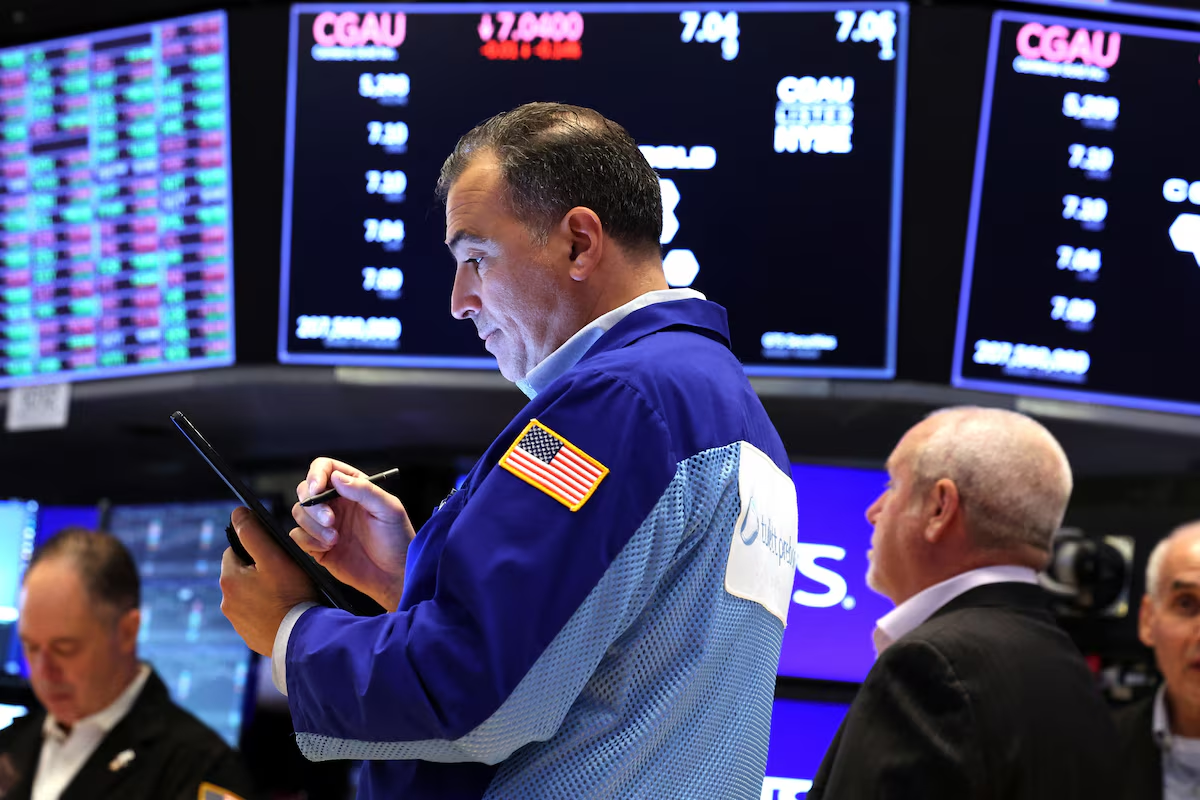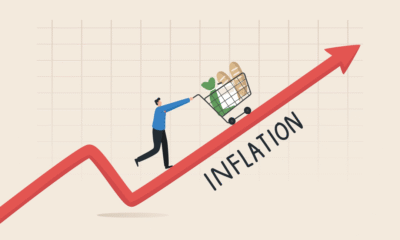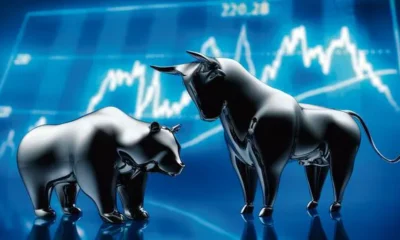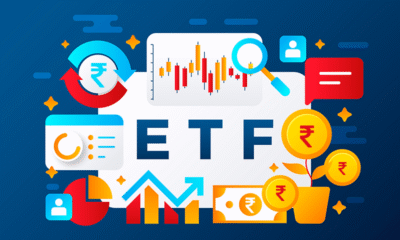Finance
Trending Finance Market News in the USA: Insights and Analysis

Introduction to the Current Finance Landscape
The finance market in the United States is currently characterized by a dynamic interplay of various economic factors that are shaping investor sentiments and strategic decisions. As we navigate through 2023, key trends such as inflationary pressures, fluctuating interest rates, and changes in consumer spending are significantly influencing market behavior and overall financial stability.
Inflation remains a critical concern for many investors. Throughout the past year, rising prices have prompted the Federal Reserve to implement measures aimed at controlling inflation, such as increasing interest rates. These monetary policies have far-reaching implications not only for corporate earnings but also for consumer sentiment and spending habits. The willingness of consumers to spend is key, as it drives economic growth; however, higher borrowing costs resulting from rising interest rates may lead to a contraction in spending, creating a potential slowdown in economic growth.
Furthermore, the labor market continues to display resilience, with low unemployment rates contributing to consumer confidence. Job growth, wage increases, and overall economic expansion play integral roles in shaping the finance landscape. As wages increase, disposable income also rises, which can stimulate spending and investment. However, this ongoing uncertainty due to high inflation can lead to a cautious approach among consumers, impacting sectors that rely heavily on discretionary spending.
In addition to these factors, the developments in global markets and geopolitical tensions have introduced layers of complexity to the U.S. finance environment. These external influences can have immediate consequences on stock market volatility, commodity prices, and foreign exchange rates. As financial analysts closely monitor these trends, understanding their ramifications is crucial for stakeholders aiming to navigate the evolving finance market successfully.
Key Economic Indicators and Their Impacts
In the context of the financial markets in the USA, key economic indicators play a pivotal role in shaping market sentiment and influencing investor strategies. Among these indicators, Gross Domestic Product (GDP) growth rates, unemployment rates, and consumer confidence indexes stand out due to their ability to provide insights into the health of the economy and future trends. Analyzing these economic metrics enables stakeholders to gauge the overall economic landscape and make informed investment decisions.
GDP growth rates serve as a fundamental indicator of economic performance. A rise in GDP typically signifies expansion, which can bolster investor confidence and positively impact equity markets. Conversely, a decline may prompt concerns over economic stagnation or contraction, thereby leading to bearish trends in the market. As of October 2023, analysts have observed moderate GDP growth driven by consumer spending and robust manufacturing output. However, any future fluctuations could significantly sway market dynamics.
Unemployment rates are another critical gauge of economic vitality. A low unemployment rate suggests a healthy job market, which can boost consumer spending and investment. Recent data indicate that unemployment rates have stabilized in the low single digits, enhancing market optimism. However, any significant increase could create concerns around economic stability, leading investors to reassess their portfolios.
Lastly, consumer confidence indexes provide insight into consumer sentiment, which is essential for economic growth. High consumer confidence generally correlates with increased spending, benefiting businesses and, consequently, the financial markets. Recent surveys indicate that consumer confidence has shown resilience, despite challenges such as inflation and interest rate hikes. Investors are closely watching these indexes as they offer predictions on future consumer behavior, thus impacting market strategies.
In the coming months, it will be essential to monitor these key economic indicators, as they will continue to influence market sentiment and shape investment directions in the USA’s finance landscape.
Sector Performance Analysis
The performance of different sectors within the US finance market provides critical insights into broader economic trends and investor sentiment. Through the analysis of key sectors such as technology, health care, and energy, we can gauge how various market forces are contributing to the overall financial landscape. Each of these sectors has exhibited distinct growth patterns and challenges, influenced by regulatory changes, technological advancements, and geopolitical dynamics.
The technology sector, historically a strong performer, continues to show resilience, primarily driven by advancements in artificial intelligence and cloud computing. Noteworthy companies within this sector have reported substantial revenue increases, bolstered by the ongoing digital transformation across industries. However, recent discussions surrounding regulatory scrutiny, particularly concerning data privacy and antitrust issues, have introduced a layer of uncertainty. Investors are closely monitoring these developments, as future regulations could shape the competitive landscape.
The health care sector has recently experienced significant volatility. While some companies have thrived due to innovations in telehealth and biotechnology, others face challenges related to changing governmental policies and pricing pressures. The ongoing debate around health care costs and reimbursement models has created a complex environment, wherein investor confidence can fluctuate based on potential legislative outcomes.
On the other hand, the energy sector is navigating a transformative period. While traditional fossil fuel industries are experiencing rising operational costs and regulatory hurdles, a notable shift towards renewable energy sources is reshaping the market. Companies focusing on sustainability and green technologies are gaining traction and attracting investment, reflecting a broader societal push for clean energy solutions.
In summary, sector performance in the US finance market is a multifaceted narrative shaped by various factors, from innovative advancements to regulatory changes. Understanding these intricacies provides a clearer picture of investment opportunities and risks inherent in individual sectors.
Stock Market Trends and Predictions
The stock market in the United States, particularly the major indices such as the S&P 500 and the Dow Jones Industrial Average, has exhibited notable behaviors in recent months. Analysts have observed increased volatility, influenced by various macroeconomic factors, including inflation rates, interest rate adjustments, and geopolitical tensions. As companies report their quarterly earnings, the market reacts dynamically. For instance, the mixed results from major tech firms have added uncertainty, affecting investor sentiment and stock valuations.
Expert opinions collectively suggest a cautiously optimistic outlook for the S&P 500, anticipating potential growth in the latter part of the year. Strategists note that, while the index has faced headwinds, several sectors, including technology and consumer goods, remain resilient. The ongoing transition towards sustainable energy and technology advancement is expected to bolster the performance of select stocks in these sectors. However, it is essential for investors to stay informed about recurring economic indicators, as they could signal fluctuations in market performance.
Similarly, the Dow Jones has experienced a blend of gains and losses, reflecting shifts in the performance of blue-chip companies. Analysts predict that as the earnings reports roll in, sectors such as finance and healthcare might outpace the general market, contributing to a potential rebound. Key indicators, including employment rates and consumer spending, will also play a critical role in shaping future trends.
Market sentiment overall remains a crucial determinant of the stock market’s direction. Investor psychology, influenced by news cycles and economic forecasts, can lead to rapid fluctuations in stock prices. Therefore, it is paramount for stakeholders to monitor both overarching economic conditions and specific corporate performances, as these factors will ultimately inform the trajectory of the stock market in the forthcoming months.
Alternative Investment Opportunities
In recent years, alternative investment opportunities have garnered significant attention from investors seeking to diversify their portfolios beyond the conventional realms of stocks and bonds. The growing interest in assets such as cryptocurrencies, real estate, and startups is driven by a multitude of factors, including the desire for higher returns and a hedge against market volatility.
Cryptocurrencies have emerged as a prominent alternative asset class, characterized by their potential for considerable returns. Blockchain technology underpins these digital currencies, providing a decentralized network that appeals to tech-savvy investors. However, the inherent volatility and regulatory uncertainties associated with cryptocurrencies present notable risks. Many investors must weigh the possibility of substantial gains against the potential for significant losses.
Real estate, another alternative investment avenue, offers opportunities for capital appreciation as well as ongoing rental income. Investing in properties can serve as a hedge against inflation, making it an attractive option for many. As demand for housing continues to rise, particularly in urban areas, real estate remains a critical consideration for those looking to secure long-term financial returns. Nonetheless, factors such as market fluctuations, property management challenges, and liquidity issues can pose risks for investors in this sector.
Moreover, investing in startups has gained popularity, particularly among individuals looking for high-risk, high-reward scenarios. Startups can offer substantial growth potential, especially in innovative sectors like technology and healthcare. Venture capitalists and angel investors often focus on these emerging companies, but they must also be prepared for the high probability of failure that accompanies new business ventures.
In essence, as investors increasingly recognize the limitations of traditional investment routes, they are steering toward alternative assets. Understanding the associated risks and rewards will be essential in navigating this evolving financial landscape.
Interest Rates and Monetary Policy Shifts
The Federal Reserve plays a pivotal role in shaping the financial landscape of the United States through its interest rate adjustments and monetary policy decisions. Recently, the Fed has made headlines with a series of interest rate hikes in response to persistent inflationary pressures. These changes have significant implications for borrowing costs across various sectors, including consumer loans, mortgages, and business financing. Higher interest rates typically translate to increased borrowing costs, which can dampen consumer spending and business investment, potentially slowing economic growth.
In the latest Federal Open Market Committee (FOMC) meeting, policymakers raised the benchmark interest rate by 25 basis points, marking the third hike this year. This decision reflects the Fed’s commitment to manage inflation, which has consistently remained above the central bank’s target of 2%. The reasoning behind these hikes is aimed at curbing excess demand in the market, thereby stabilizing prices. However, analysts are closely monitoring the potential trade-offs between controlling inflation and fostering an environment conducive to growth.
Looking ahead, the trajectory of monetary policy will depend on various economic indicators, including employment rates and consumer sentiment. The Fed has signaled that future rate hikes may occur, albeit cautiously, as they navigate inflation concerns while striving to sustain a healthy labor market. Moreover, the evolving global economic landscape, including geopolitical tensions and supply chain disruptions, may further influence the Fed’s decisions. Investors, economists, and market participants remain vigilant, as shifts in interest rates can create ripples throughout the financial markets, affecting investment strategies and overall economic confidence.
Overall, the Federal Reserve’s adjustments to interest rates represent a crucial aspect of its monetary policy framework and a significant determinant of the finance market’s direction in the USA. Understanding these changes is essential for stakeholders across the economy.
Impact of Geopolitical Events on the Finance Market
The finance market in the United States is significantly influenced by various geopolitical events, including trade agreements, international conflicts, and policy changes. Such events can create considerable volatility in financial markets, impacting investor sentiment and economic indicators. A recent example is the trade negotiations between the USA and China, which have resulted in fluctuations in exchange rates and stock prices. Expectations surrounding these negotiations can lead to increased speculation, particularly in sectors reliant on international trade.
Furthermore, international conflicts often prompt reactions from financial markets as investors seek safer assets. The ongoing tensions in Eastern Europe, for example, have led to a flight to quality, with many investors shifting their assets to U.S. Treasury bonds, thereby pushing down yields. This is indicative of how geopolitical stability can directly influence the demand for financial instruments, shaping market dynamics.
Moreover, the interplay between domestic and global economic policies is crucial. Central banks, such as the Federal Reserve, must respond to international developments, which can lead to adjustments in interest rates or quantitative easing measures. These policy shifts can cause ripple effects across the finance market, significantly altering the investment landscape. In addition, geopolitical developments often result in commodity price fluctuations, particularly in oil and gas, which can impact the performance of U.S. companies operating in those sectors.
As such, monitoring geopolitical events is essential for investors and analysts focused on the finance market. Understanding the implications of these developments can aid in formulating informed investment strategies, given that the financial market’s responsiveness to global events is paramount. Ultimately, the connection between geopolitical occurrences and market performance underscores the need for a comprehensive approach to financial analysis, incorporating international factors alongside domestic considerations.
Technological Innovations in Finance
The finance market in the USA has experienced a significant transformation due to technological innovations. Fintech, blockchain technology, and artificial intelligence (AI) are at the forefront of this evolution, reshaping how transactions are conducted and how financial institutions operate. Fintech, in particular, has democratized access to financial services, enabling a broader range of consumers and small businesses to engage with financial products that were previously limited to larger institutions.
One of the most notable trends is the rise of blockchain technology, which offers a decentralized and secure method for conducting transactions. Blockchain enhances transparency and efficiency in contract execution and record-keeping. Its incorporation into investment transactions allows for reduced costs and faster processes, making it an attractive option for both investors and institutions. As organizations start to recognize the potential of blockchain, several are exploring its applications beyond cryptocurrencies, including supply chain financing and identity verification.
Artificial intelligence is another critical player in this technological shift. AI algorithms analyze vast amounts of data to identify patterns, predict market trends, and assist in decision-making. This technology streamlines due diligence processes, providing investors with insights that were previously difficult to obtain. Additionally, AI-powered chatbots enable financial institutions to improve customer service by providing instantaneous support and solutions to client queries.
As these innovations continue to evolve, they create a more dynamic landscape for investors. The adoption of technology allows for greater accessibility to investment opportunities, driving engagement among newer generations looking to invest. Financial institutions are also compelled to adapt, fostering new strategies and partnerships to remain competitive in an increasingly tech-driven environment. This confluence of technology and finance marks the beginning of a new era in market operations, poised to reshape future interactions within the financial ecosystem.
Conclusion and Future Outlook
As we navigate the complex landscape of the US finance market, it is imperative to reflect on the insights garnered from recent developments. The market has experienced significant fluctuations influenced by various factors, including interest rates, inflationary trends, and geopolitical uncertainties. Understanding these dynamics is crucial for investors who are seeking to make informed decisions in today’s environment.
Among the key takeaways, the persistent rise in interest rates has emerged as a critical factor affecting both stock and bond markets. Investors should be aware that higher rates may lead to increased borrowing costs, potentially slowing down consumer spending and corporate expansion. Furthermore, inflation continues to pose challenges, prompting the Federal Reserve to adjust its monetary policy in response to changes in price stability. This evolving landscape necessitates ongoing vigilance and adaptability from market participants.
Looking ahead, investors are encouraged to adopt a strategic approach to navigating the current finance climate. Diversification remains a prudent strategy, as it can mitigate risks associated with volatility in specific sectors. Additionally, staying informed about macroeconomic indicators will aid in anticipating market shifts. Engaging in asset allocation based on individual risk tolerance and financial goals will also be paramount in achieving long-term success.
In summation, the US finance market is poised for further transformations as economic indicators unfold. By remaining proactive and leveraging analytical insights, investors can better position themselves to capitalize on emerging opportunities while managing associated risks. The future of the finance landscape is uncertain, but with strategic foresight, one can navigate the twists and turns effectively.
Investing
Global Investor Outflows from U.S. Stocks & Dollar

In a shift that is sending ripples across financial markets, institutional investors around the world are pulling back from U.S. equities and reducing exposure to the U.S. dollar, signaling a significant change in sentiment toward American assets. According to the latest Bank of America Global Fund Manager Survey, global investors are now the most underweight on U.S. stocks in more than two decades, with the dollar facing similar skepticism as a long-term safe-haven asset. This transition is being fueled by multiple converging factors, including geopolitical instability, growing U.S. fiscal deficits, trade tensions, and an increasingly favorable investment climate in Europe and select emerging markets. For investors, economists, and policymakers alike, this trend represents a rebalancing of global capital flows that could reshape market dynamics in the months ahead.
Investor Sentiment Toward U.S. Markets Hits Multi-Year Lows
The Bank of America survey, considered a key barometer of global institutional sentiment, reveals that fund managers have turned heavily underweight on U.S. stocks and the dollar, preferring instead to rotate their portfolios into European and Asian equities. The survey showed that 36% of participants are now net underweight U.S. equities—the highest level since 2003. At the same time, positioning on the dollar turned net negative for the first time in over five years, with investors citing mounting fiscal concerns, valuation extremes, and weakening macroeconomic indicators.
The U.S. equity market, especially the tech-heavy NASDAQ, has experienced an extraordinary bull run over the last several years. But now, investors are questioning the sustainability of elevated valuations, particularly as economic growth slows, earnings forecasts are revised downward, and inflation remains persistently above target. Many portfolio managers believe the best returns may no longer be found in U.S. assets alone.
Rising U.S. Debt and Fiscal Deficits Raise Red Flags
A key driver of investor caution is the ballooning U.S. fiscal deficit. The Congressional Budget Office (CBO) projects that the U.S. federal deficit will reach over $1.8 trillion this year, driven by increased government spending, rising interest costs, and lower-than-expected tax revenues. The national debt is now projected to exceed 125% of GDP by 2030, raising serious questions about long-term fiscal sustainability.
Investors fear that soaring U.S. debt levels could lead to a loss of confidence in Treasury securities, pushing yields higher and triggering volatility in global credit markets. This concern is magnified by the growing political polarization in Washington, which has led to repeated debt ceiling standoffs and policy gridlock. As a result, some asset managers are choosing to diversify their bond portfolios with sovereign debt from countries like Germany, Canada, and Australia—nations viewed as having stronger fiscal discipline.
Geopolitical Tensions Erode Dollar Safe-Haven Appeal
The traditional role of the U.S. dollar as a global safe-haven currency is also being called into question. With the U.S. now embroiled in rising geopolitical conflicts, including its military engagement in the Middle East and an escalating trade war with China, the perception of the dollar as a “neutral” or stable currency is beginning to fade. Several countries, particularly in the Global South, have voiced frustration over the dominance of the dollar in international trade, and some have even accelerated efforts to settle trade in alternative currencies such as the euro, yuan, or local currency blocs.
In response, central banks in emerging markets are reducing their U.S. dollar reserves and increasing holdings in gold and non-dollar currencies. This trend, while gradual, is gaining momentum and contributing to the dollar’s underperformance against a basket of global currencies. The U.S. dollar index (DXY) has declined by nearly 6% year-to-date, reflecting both diminished investor confidence and a broader reconfiguration of reserve management strategies.
Attractive Valuations Abroad Drive Capital Outflows
While risks in the U.S. are mounting, attractive investment opportunities abroad are also contributing to the outflow of capital from American markets. European equities, particularly in sectors like green energy, luxury goods, and financial services, are seeing renewed interest thanks to relatively low valuations and improving macroeconomic stability. The recent ECB rate cuts and Eurobond discussions have added to optimism about the region’s fiscal and financial integration.
In Asia, countries like India, Indonesia, and Vietnam are emerging as new hotspots for foreign direct investment and equity inflows. These economies offer robust growth prospects, younger demographics, and increasingly tech-driven industries. Additionally, Japan’s bond market is seeing increased institutional buying, as long-term yields rise in response to the Bank of Japan’s policy changes.
This global diversification strategy is not just about seeking higher returns—it’s also about managing risk. Investors are increasingly looking to balance their portfolios geographically, reducing dependence on any single region and hedging against macroeconomic shocks that may be specific to the U.S.
Currency Hedging and Diversification as Defensive Strategies
In response to the dollar’s volatility, many fund managers are now engaging in currency hedging strategies to protect their portfolios. Currency ETFs, options, and forward contracts are being used to minimize the downside risk of a weakening dollar. At the same time, global investment funds are ramping up their exposure to non-dollar-denominated assets, including eurozone corporate bonds, emerging market debt, and local-currency sovereign issues.
Moreover, ESG and green bond markets in Europe and Asia are attracting capital due to their alignment with global sustainability goals. These instruments not only offer diversification but also align with broader institutional mandates on responsible investing.
Implications for U.S. Markets and Monetary Policy
The capital flight from U.S. assets could have significant implications for American markets. A persistent decline in foreign demand for U.S. Treasuries may force the Federal Reserve to intervene more frequently in the bond market to maintain liquidity and control yields. At the same time, a weaker dollar could contribute to imported inflation, complicating the Fed’s efforts to bring core inflation back within its target range.
On the equities side, if investor outflows persist, U.S. companies may face higher capital costs and declining valuations, particularly in sectors that rely heavily on foreign investment or exports. Domestic pension funds and institutional investors may need to fill the gap left by global investors, which could further alter asset allocation strategies and influence corporate financing decisions.
A New Era of Global Capital Rotation
The growing shift away from U.S. stocks and the dollar signals the beginning of a new era in global investing, one defined by diversification, geopolitical hedging, and currency rebalancing. While the U.S. remains a central player in global finance, the days of unquestioned dominance are beginning to fade, as investors embrace a more nuanced and distributed view of risk and opportunity.
For market participants, staying agile in this environment means tracking global fund flows, monitoring geopolitical developments, and reassessing the traditional U.S.-centric portfolio model. As capital continues to flow into European and Asian markets, the future of global finance is being rewritten—and those who adapt early may find themselves ahead of the curve.
Finance and Economy
France Pushes Eurozone Toward Joint Eurobond Issuance

In a bold move that could redefine the financial architecture of the European Union, France has renewed its push for the issuance of joint eurozone debt instruments – commonly referred to as Eurobonds – as a way to strengthen the euro on the global stage. As the EU prepares for its upcoming summit on June 26-27, the proposal is once again stirring heated debate among member nations. French officials argue that a shared debt mechanism is essential not only for financial resilience but also for elevating the euro’s standing as a credible alternative to the U.S. dollar. While the idea garners support from key institutions like the IMF and the ECB, resistance from fiscally conservative member states continues to block consensus. This article explores the implications of France’s proposal, the potential benefits and challenges of Eurobond issuance, and the evolving role of the euro in a multipolar financial world.
France’s Strategic Case for Eurobonds
French President Emmanuel Macron and Finance Minister Bruno Le Maire have long been advocates for deeper EU financial integration. According to them, Eurobonds would represent a tangible step toward fiscal solidarity and monetary cohesion, allowing member nations to borrow at collectively favorable rates while demonstrating political unity. The latest push comes at a time when the European economy is facing several headwinds: slowing growth, fragmented recovery across member states, and heightened global financial volatility triggered by geopolitical conflicts and energy insecurity. Macron has reiterated that a common debt tool is essential for financing major EU-wide projects such as green energy transition, digital infrastructure, and military defense.
From a strategic standpoint, France views Eurobonds as more than just a financial mechanism – they are a symbol of EU credibility and resilience. By pooling risk and aligning borrowing capacity, the eurozone could present a united front in capital markets, reducing the vulnerability of weaker economies and improving the euro’s attractiveness to foreign investors.
The Euro’s Current Global Standing and Its Challenges
Despite being the world’s second most-used currency, the euro still lags far behind the U.S. dollar in terms of global reserve share, trade settlement, and safe-haven preference. Analysts point out that one of the primary reasons for this is the fragmented nature of the eurozone bond market. Each country issues its own sovereign debt, leading to a lack of a single, risk-free eurozone bond benchmark – unlike U.S. Treasuries, which offer deep liquidity and low risk.
France’s proposal seeks to address this imbalance. A unified Eurobond market could create a highly liquid, stable, and scalable financial product that would attract central banks, pension funds, and sovereign wealth investors. Over time, this could shift more global reserves into euros, boosting the currency’s influence in global trade and finance.
Institutional Support: IMF, ECB, and Market Participants
Key international organizations have thrown their weight behind the idea. The International Monetary Fund (IMF) has suggested that Eurobonds could enhance the EU’s fiscal capacity and crisis response agility. Meanwhile, European Central Bank (ECB) officials, including President Christine Lagarde, have hinted that deeper fiscal integration is necessary for the euro to realize its full potential.
Financial market participants have also shown interest. Asset managers argue that Eurobonds could become a cornerstone of fixed-income portfolios, particularly for investors looking to diversify away from dollar-denominated assets. Some analysts compare the opportunity to the creation of the U.S. Treasury market in the post-war era, which laid the groundwork for the dollar’s global dominance.
Opposition from the Frugal Four and Risk-Sharing Concerns
Despite France’s enthusiasm and institutional support, significant opposition persists from fiscally conservative EU nations, notably Germany, Austria, the Netherlands, and Finland—often dubbed the “Frugal Four.” These countries argue that shared debt would penalize responsible fiscal behavior and open the door to moral hazard, where weaker economies might overborrow under the protection of joint guarantees.
German officials have also cited constitutional constraints and public opposition to any perceived “debt mutualization.” Instead, they advocate for reforms at the national level, more stringent budget controls, and the use of existing mechanisms like the European Stability Mechanism (ESM) for crisis funding.
This divide continues to stall formal negotiations. At the heart of the debate is the question of trust and fiscal governance, as many northern states remain skeptical about the long-term commitment of their southern counterparts to austerity and budget discipline.
Implications for Financial Markets and Investors
If approved, Eurobonds would be a game-changer for European capital markets. They would offer a new safe asset class, potentially rivaling U.S. Treasuries in size and reliability over the long term. For the European banking system, Eurobonds could provide high-quality collateral and improve liquidity conditions, especially for cross-border lending.
Investors are closely monitoring the situation. If the EU takes concrete steps toward joint bond issuance, bond yields across peripheral economies like Italy, Spain, and Greece could compress further, as risk premia shrink in anticipation of shared guarantees. Simultaneously, euro-denominated assets may see a surge in foreign inflows, especially from central banks seeking to rebalance reserve portfolios.
Strengthening the Euro’s Role in a Multipolar World
The geopolitical landscape is increasingly defined by multipolarity, with China, Russia, and the U.S. competing for influence in trade, finance, and security. In this context, the eurozone faces a historic opportunity to carve out a more assertive role. Strengthening the euro through fiscal and capital market integration is seen as essential to counterbalance the dollar’s dominance and reduce reliance on U.S.-led financial infrastructure.
Eurobonds could serve as a financial pillar in this transition. As global investors seek alternatives in a fragmented world economy, the euro’s rise as a stable, investable, and liquid currency backed by joint instruments could bolster its credibility and utility.
A Defining Moment for European Unity
France’s push for Eurobonds is more than just a fiscal proposal – it is a call for political and financial unity in a time of global uncertainty. While the road to consensus is steep, the growing support from institutions, investors, and southern EU members suggests that momentum is building. The upcoming EU summit will be a crucial test of the bloc’s ability to move beyond national interests and toward a shared financial future.
If successful, Eurobond issuance could redefine the eurozone’s role in the global economy, offering new tools for crisis response, economic development, and financial competitiveness. For investors and policymakers alike, this moment marks a critical juncture – either Europe seizes the opportunity to lead, or it risks remaining a secondary player in a rapidly evolving financial world.
Finance and Economy
Oil Price Spike as Middle East Conflict Deepens: A Global Market Wake-Up Call

The financial world is once again on high alert as escalating tensions in the Middle East have triggered a sharp surge in global oil prices, sending shockwaves through equity, commodity, and currency markets alike. With the U.S. reportedly striking Iran’s nuclear sites, Brent crude surged over 18%, nearing $80 per barrel in a matter of hours. The sudden volatility reignited fears of a potential $100 oil scenario, reminiscent of past geopolitical flashpoints that deeply impacted global supply chains, inflation expectations, and central bank policy stances. This article delves into the causes, consequences, and global financial implications of this emerging crisis.
The Trigger: U.S. Strikes on Iran’s Nuclear Infrastructure
On June 21, 2025, international news outlets confirmed that U.S. military forces had targeted Iranian nuclear facilities in what they described as a “pre-emptive defensive measure.” While the full extent of the damage is still being assessed, the attack has clearly escalated tensions in an already volatile region. The Middle East, being a vital hub for global oil production and shipping, plays a significant role in maintaining supply stability. Iran, which controls access to the Strait of Hormuz – a key chokepoint through which nearly 20% of the world’s oil supply passes—responded with threats to close the strait and intensify its military posturing. This heightened the risk premium in energy markets virtually overnight.
Oil Prices React Swiftly to Geopolitical Instability
Crude oil, especially Brent and West Texas Intermediate (WTI), reacted with extreme sensitivity to the developments. Brent crude jumped over 18% within a 24-hour period, while WTI saw a comparable surge. Analysts at Goldman Sachs and JPMorgan warned that if the Strait of Hormuz were to be blocked, prices could surpass $100 per barrel within weeks. The last time the oil market saw such an intense geopolitical premium was during the 2019 drone attacks on Saudi oil facilities. However, the current situation has a more severe undertone due to the involvement of nuclear assets and direct military strikes between two powerful adversaries.
Safe Haven Assets Soar as Risk Appetite Declines
As is common in times of geopolitical crisis, investors flocked to safe-haven assets such as gold, the U.S. dollar, and U.S. Treasuries. Gold climbed above $2,400 per ounce, a level not seen in years, while the U.S. dollar index rose nearly 2% as capital fled emerging markets and riskier assets. Meanwhile, 10-year U.S. Treasury yields fell sharply, reflecting a surge in demand for perceived low-risk instruments. Cryptocurrency markets, particularly Bitcoin, experienced a brief rally as some investors viewed digital assets as alternative stores of value, although that rally quickly reversed amid broader market instability.
Stock Markets Face Broad Sell-Off, Led by Energy-Sensitive Sectors
Equity markets around the globe responded negatively. The S&P 500 and NASDAQ both dropped over 2.5% in intraday trading, led by declines in consumer discretionary, industrials, and airline stocks, which are highly sensitive to fuel price increases. European indices such as the FTSE 100 and DAX also saw steep losses, while Asia-Pacific markets like the Nikkei 225 and Hang Seng Index fell sharply as investors priced in a higher global risk premium. Interestingly, energy stocks provided the only bright spot in an otherwise red sea of market activity, with companies like ExxonMobil and Chevron posting strong gains on expectations of rising revenues.
Inflationary Pressures Could Derail Central Bank Strategies
The surge in oil prices couldn’t have come at a worse time for global central banks. After years of battling inflation through aggressive interest rate hikes, many central banks had only just begun to pause or consider rate cuts in 2025. However, higher energy prices feed directly into inflation, particularly in transport, manufacturing, and agriculture sectors, potentially forcing monetary authorities to reverse their dovish pivot. The European Central Bank (ECB), which had recently initiated its first rate cut in years, may now face pressure to hold off on further easing. Similarly, the Federal Reserve, which had opted to maintain its current rate in the last FOMC meeting, is likely to adopt a more hawkish tone moving forward.
Emerging Markets Bear the Brunt of the Crisis
The fallout from spiking oil prices is especially damaging for emerging markets, which are typically more sensitive to commodity price fluctuations. Countries like India, Turkey, and South Africa, which are major oil importers and have significant current account deficits, saw their currencies depreciate against the dollar. This adds to inflationary pressures and increases the cost of dollar-denominated debt, complicating fiscal and monetary policy responses. Foreign institutional investors also withdrew capital from these markets, adding to equity market stress and further depressing sentiment.
Global Economic Growth at Risk
Economists are revising down global GDP forecasts amid fears that higher oil prices will dampen consumer spending, elevate production costs, and destabilize corporate earnings. According to the IMF, a sustained oil price above $90 could reduce global GDP growth by 0.5% annually, with some regions like Southeast Asia and Sub-Saharan Africa experiencing even greater negative impacts. Supply chains, already recovering from post-pandemic disruptions and trade tensions, now face renewed uncertainty due to potential shipping bottlenecks in the Persian Gulf.
Outlook: What Comes Next for Markets and Policymakers?
Going forward, much depends on how the situation in the Middle East evolves. A de-escalation through diplomatic channels, possibly via UN or EU mediation, could stabilize oil prices and soothe market nerves. On the other hand, if Iran follows through on its threat to block the Strait of Hormuz or retaliates militarily, the crisis could escalate into a full-blown regional conflict with severe repercussions for global trade and energy supply. Policymakers worldwide are monitoring the situation closely, and emergency meetings by OPEC and G20 finance ministers are already being planned. The International Energy Agency (IEA) has also signaled its willingness to release strategic petroleum reserves if needed to calm markets.
The Road Ahead is Uncertain but Manageable
In the face of rising geopolitical tensions and economic uncertainty, investors are advised to adopt a cautious, diversified approach. While markets remain volatile and unpredictable, sound investment principles – such as maintaining a balanced portfolio, avoiding over-leveraged positions, and focusing on long-term fundamentals – remain more relevant than ever. The oil price spike triggered by the U.S.-Iran conflict is a potent reminder of how global politics and finance are deeply intertwined, and why staying informed and agile is critical in today’s interconnected world.
-

 Finance & Investment6 months ago
Finance & Investment6 months agoEmerging Markets to Watch in 2025: Opportunities and Risks
-

 Technology and Finance8 months ago
Technology and Finance8 months agoThe Future of Quantum Computing in Financial Modeling and Trading
-

 Finance7 months ago
Finance7 months agoUSA Market Trends & Global Finance Insights
-
Finance7 months ago
Navigating Retirement in the Gig Economy: Challenges and Solutions
-

 Finance8 months ago
Finance8 months agoNavigating Personal Finance in the Age of Inflation and High Interest Rates
-

 Economics6 months ago
Economics6 months agoGlobal Markets React to U.S. GDP Contraction: A Comprehensive Analysis
-

 Investing & Finance8 months ago
Investing & Finance8 months agoFractional Investing: The Path to Wealth Democratization
-

 Finance7 months ago
Finance7 months agoTop 10 High-Yield Savings Accounts in the US (2025 Edition)
















